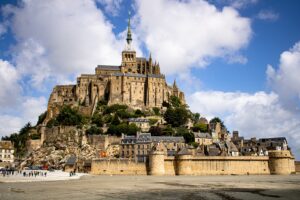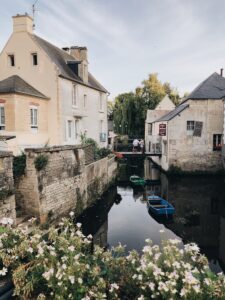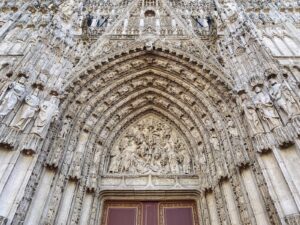While we are all cooped up waiting for our quarantine days to end, let’s do a little travel dreaming. I’ve been thinking about how amazing the Normandy Region is. It’s got a bit of all the things that make a trip so globally literate: history, art, food, architecture, and local joie de vie. There’s a wonderful sense of time gone by and sentimentality that allows you to take a deep breath of sea air and enjoy an area dotted with french delights. It’s a part of the French experience well worth the time. Let’s dig in and look at some of the icons and off the beaten path moments that make Normandy magnifique! 🇫🇷
Mont Saint Michel
Starting in the West, Normandy welcomes you with a jaw dropper. The iconic Mont Saint Michelle is a study in how architecture is breathtaking from both far away and up close. To say it dominates the landscape is an understatement! It carves itself into the skyline in a way that Disney himself could only dream of. But, upon closer inspection, the Mont delights with its nooks and crannies that showcase medieval technology and know-how. Moreover, a visit here comes with quite a few unique experiences. From walking around the whole base of the island on the tidal flats to climbing to the very top to the religious heart and purpose of the Mont, there is something for everyone.
Quiet refuge awaits those who need a moment of meditation with the glorious views but hustle and bustle are just around the corner on the main path with a treasure trove of gift shops, restaurants, and B&Bs to fit any traveler’s needs. Any thorough exploration of this unbelievable place takes a bit more than a day and can be enhanced by staying in one of the rustic B&Bs in the island village or just over the water at one of the many hotels available. The best times to enjoy the village is before or after the big bus tours take over while the tidal flats beckon you mid day.
Bayeux and The Beaches
Probably the most recognizable destination in Normandy, for Americans and Brits, at least, is the beach. Particularly Omaha, Utah, and Gold Beaches as these were the ground zero of the World War II invasion. The area around the American sector is an amazing time capsule of the 1940’s as American GIs finally got their foothold in Europe with the other allied forces. Fifty four miles of coastline await your exploration of the events that we call D-day. Start toward the west at Utah Beach and follow the story all the way to Arromanches. WWII buffs and novices alike will not be disappointed! East if Arromanches are the Canadian and British sectors. Unlike the American sector, these areas have been a built up and don’t hold the same interest as the western areas. There is one small exception, the museum on Juno Beach which is tiny but well laid out.
Just inland, is the charming town of Bayeux which makes a well positioned home base for coastal Normandy. Bayeux itself holds a treasure not related to D-day but, rather, another invasion that changed the world back in 1066. Way back then, the world’s first 64 meter comic strip now called the Bayeux Tapestry, was lovingly stitched for display in the local cathedral. This particular story makes sure that William, the new king of England would forever be known as William the Conquerer. He took out his rival, Harold and the tapestry caught the whole story play by play. To take in both Bayeux and the beaches, plan on three days: One to visit everything west of the cemetery, another to visit the cemetery and Arromanches, and a last day for Bayeux and the surrounding area which are filled with plenty of apple cider producing orchard.
Caen Remembers
Round out your D-day experience by visiting the Caen Peace Memorial. This is a beautiful tribute to the sacrifices it took to win the war and the ensuing years of reconstruction and political upheaval. It takes a little more than half a day to see all this museum has to offer.
Giverny
Artistically speaking, Normandy holds some of the world’s greatest treasures. Home town hero Claude Monet lived his more mature years invested in the little artist colony of Giverny on the eastern side of Normandy very close to Paris. His creation of the impressionist movement holds the entire region in high esteem. However, his opus is his garden. Monet became entranced with finding the light among his garden that was planted with an artist’s eye rather than a horticulturist’s eye. This allowed the color and seasonality of each area of the garden to thrive and lend itself wholeheartedly to the master’s canvas.
Today, Monet’s oasis does not disappoint. Despite the crowds, the gardens delight the senses and the house allows you to time travel back to a time when Impressionism was at its bohemian height. Adjacent to the very popular property is the village full of restaurants, galleries, a church, and one of the best secrets in the area: The Museum of Impressionism. This gem hosts the story of the art form including its unlikely sources of inspiration. It’s the perfect size for the beginning art lover in all of us. In short, Normandy’s Giverny can be equated with one simple word: delightful. Plan on giving Giverny at least a day so that you can not only take in the gardens but the lovely village.

Honfleur and Rouen
Monet did not isolate himself in Giverny but instead spent plenty of time in other Norman gems including Honfleur, Le Havre, and Rouen. The seaside beckoned him to charming Honfluer where he put the magical harbor on canvas time and time again. Today’s Honfleur is the same seaside port with charming art galleries, amazing seafood restaurants, and views around every corner. Honfleur’s appeal isn’t tied up in any one particular sight. While there is a charming, seafaring church and a museum dedicated to Saitee, Honfluer is more about taking in the overall atmosphere. So, stroll along the waterfront, eat at an enticing restaurant, window shop to your heart’s content, set up an easel and give Impressionism a shot, there’s no rush. It’s a perfect overnight stay to ensure that you include some downtime in your vacation.
Rouen may have been Monet’s muse second only to those water lilies. This half-timbered town holds two important stories. The first is the cathedral. While not France’s most popular or fanciest church but it was the one Monet couldn’t walk away from. He painted throughout the day trying to do that thing impressionists do so well: “capture the light”. The cathedral was wounded during WWII pretty severely and rebuilding and conservation continue to happen in one way or another. One of the town’s best kept secrets for the art lover is the Museum of Fine Arts. The museum is intimate and not overcrowded like so many of its Parisian cousins. Get up close to the canvas and then step back to get the full effect. Compare the styles of Monet with those of his contemporaries like Renoir.
Meet Joan…
While Monet may be popular here, it’s Joan of Arc that dominates the town’s narrative. The young girl rose to fame or infamy, depending on who you were at the time, and became the confidant of French kings for a time. But, her luck was running out. Poor Joan couldn’t catch a break at the end and the authorities burned her at the stake then through her remains into the Seine River. You can follow most of her story here from relative obscurity to King’s court to the fire that took her all over town.
Architecture, history, and art work up quite the appetite! And Normandy delivers on every level! So, go, enjoy, and come back with memories to last a lifetime. Se magnifique!






